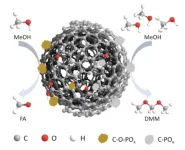(Press-News.org) An unexpected find has enabled important progress to be made in the battle against harmful bacteria.
An international team of researchers, led by Professor Peter Fineran from the University of Otago, investigated a particular protein used by bacteria-infecting viruses, known as phages.
Research into this microscopic arms race between bacteria and phages is important as it can lead to alternatives to antibiotics.
Published in prestigious international journal Nature, the study analysed a protein phages use when deploying anti-CRISPR, their method of blocking the CRISPR–Cas immune system of bacteria.
Lead author Dr Nils Birkholz, of Otago’s Department of Microbiology and Immunology, says understanding how phages interact with bacteria is an important step on the path to using phages against bacterial pathogens in human health or agriculture.
“Specifically, we need to know about the defence mechanisms, such as CRISPR, that bacteria use to protect themselves against phage infection, not unlike how we use our body’s immune system against viruses, and how phages can counteract these defences.
“For example, if we know how phages kill a specific bacterium, this helps identify appropriate phages to use as antimicrobials. More specifically, it is important to understand how phages control their counter-defence arsenal, including anti-CRISPR, upon infection – we must understand how phages regulate the expression of genes that are useful in their battle against bacteria,” he says.
The research revealed just how carefully phages need to deploy their anti-CRISPRs.
“We already knew that a particular phage protein has a part, or domain, that is very common in many proteins involved in gene regulation; this helix–turn–helix (HTH) domain is known to be able to bind DNA sequences specifically, and depending on the context, can turn a gene on or off.
“What we found is the HTH domain of this protein is much more versatile and exhibits a regulatory mode which was previously unknown. It can use this domain to not only bind DNA, but also its RNA transcript, the molecule which acts as a mediator between the DNA sequence and the anti-CRISPR encoded in it.
“Because this protein is involved in regulating the production of an anti-CRISPR, it means this regulation has additional layers– it happens not only through the DNA binding mechanism, but also through the new mechanism we discovered of binding the messenger RNA.”
Professor Fineran says the finding could have big implications for the understanding of gene regulation.
“Unravelling this unexpectedly complex regulation is important progress when it comes to understanding how phages can evade CRISPR–Cas defences and kill target bacteria in a range of applications.
“The discovery is particularly exciting for the scientific community because it shows a novel regulatory mechanism in a well-studied family of proteins.
“HTH domains have been thoroughly investigated since they were discovered in the early 1980s, so we initially thought our protein would act just like any other protein with an HTH domain – we were very surprised when we uncovered this new mode of action.
“This finding has the potential to change the way the field views the function and mechanism of this critical and widespread protein domain, and could have big implications for our understanding of gene regulation,” he says.
END
Surprise discovery with big scientific potential
2024-07-10
ELSE PRESS RELEASES FROM THIS DATE:
The plague may have caused the downfall of the Stone Age farmers
2024-07-10
Ancient DNA from bones and teeth hints at a role of the plague in Stone Age population collapse. Contrary to previous beliefs, the plague may have diminished Europe's populations long before the major plague outbreaks of the Middle Ages, new research shows.
In the 14th century Europe, the plague ravaged the population during the so-called 'Black Death,' claiming the lives of nearly a third of the population.
But the plague arrived in Scandinavia several thousand years earlier, and despite several theories suggesting otherwise, the plague might have caused an epidemic, according to new research from ...
When there’s money to lose, phone usage while driving drops
2024-07-10
PHILADELPHIA— To make someone put their phone down while driving, show them the money—with a catch, according to new research published in JAMA Open. When a group of auto insurance customers were tempted with a cash incentive—and regular feedback letting the driver know how they were doing compared to other drivers trying to reduce their phone time—handheld phone use dropped significantly, a team at the Perelman School of Medicine at the University of Pennsylvania found.
The researchers examined several different strategies ...
Astronomers find missing link in massive black hole formation
2024-07-10
Omega Centauri is a spectacular collection of 10 million stars, visible as a smudge in the night sky from Southern latitudes. Through a small telescope, it looks no different from other so-called globular clusters; a spherical stellar collection so dense towards the center that it becomes impossible to distinguish individual stars. But a new study, led by researchers from the University of Utah and the Max Planck Institute for Astronomy, confirms what astronomers had argued about for over a decade: Omega Centauri contains a central black hole. The black hole appears to be the missing link between its stellar ...
Researchers build first-ever molecular atlas of blood vessel pathways in the human brain, across early brain development, adulthood and disease
2024-07-10
An international consortium of researchers led by University Health Network (UHN) in Toronto and University of Zurich have built the first-ever molecular atlas of the human brain vasculature at single-cell resolution, spanning from early development to adulthood and through disease stages such as brain tumours and brain vascular malformations.
The international consortium includes research teams from UHN’s Krembil Brain Institute, Donald K. Johnson Eye Institute, Toronto General Hospital Research Institute and Princess Margaret Cancer Centre, the University of Toronto’s Donnelly Centre, Mount Sinai Hospital’s Lunenfeld-Tanenbaum ...
Antiferromagnetic phase transition observed in fermionic Hubbard quantum simulator
2024-07-10
In a study published online in Nature, a research team led by Prof. PAN Jianwei, Prof. CHEN Yuao, and Prof. YAO Xingcan from the University of Science and Technology of China (USTC) of the Chinese Academy of Sciences has, for the first time, observed the antiferromagnetic phase transition within a large-scale quantum simulator of the fermionic Hubbard model (FHM). This study highlights the advantages of quantum simulation. It marks an important first step towards obtaining the low-temperature phase diagram of the FHM and understanding the role of quantum magnetism in the mechanism of high-temperature ...
A drug that lowers blood lipids could help treat the world’s most common liver disease
2024-07-10
The University of Barcelona has led a study that suggests using the drug known as pemafibrate to treat liver disease associated with metabolic disorders, the most common liver pathology in the world, which affects one in four people. The drug has long been marketed in Japan for another use: improving blood lipid levels in patients with hyperlipidaemia, a common condition in diabetics. Now, however, it could help address this serious liver disease, which still has no specific treatment.
The study, carried out on laboratory animal models and published in the journal Biomedicine & Pharmacotherapy, was conducted by a team led by Professor Juan ...
Ochsner, AJMC® partner for conference on value-based care on July 25 in New Orleans
2024-07-10
NEW ORLEANS – Ochsner Health’s Healthy State initiative, in partnership with The American Journal of Managed Care, will host a free conference on value-based care from 3:30-7 p.m. on Thursday, July 25 at The Westin New Orleans hotel in Louisiana.
Registration and program details are available here for “Healthy State: Know It, Own It, Live It: Creating a Thriving Louisiana Through Innovation in Value-Based Care.” The event is open to the public, medical professionals, health policy experts and community organizers.
Organized ...
NIH funds consortium to accelerate development of new TB treatments
2024-07-10
A new consortium co-led by Weill Cornell Medicine, has been awarded a five-year, $31 million grant from the National Institutes of Health’s National Institute of Allergy and Infectious Diseases to accelerate the development of faster, more effective treatment regimens for tuberculosis (TB). Investigators at the University of California, San Francisco; Johns Hopkins Medicine; and Vanderbilt University Medical Center comprise the other co-leads.
The Preclinical Design and Clinical Translation ...
Older women more likely to receive heart surgery, die at low quality hospitals
2024-07-10
Women over the age of 65 who require complex heart surgery are more likely than men to receive care at low quality hospitals — where they also die in greater numbers following the procedure, a Michigan Medicine study finds.
The research, published in JAMA Network Open, covered nearly 450,000 Medicare beneficiaries who underwent coronary artery bypass grafting, or heart bypass surgery, between late 2015 and early 2020.
Compared to men, women were 1.26 times more likely to be treated at low quality hospitals, meaning facilities with the highest 30-day mortality rates.
At those low quality hospitals, ...
Nanocarbon catalyst design unlocks new avenue for sustainable fuel additive production
2024-07-10
Vehicle exhaust from fossil fuel combustion constitutes a main source of air pollutants like carbon dioxide and carbon monoxide. To mitigate air pollution, researchers are looking into additive to fuels like dimethoxymethane (DMM). But DMM production brings its own environmental hazards.
In their paper published June 21 in Carbon Future, a Chinese research team demonstrated how a series of phosphorous-modified nanocarbon catalysts could advance green DMM production.
Unique fuel properties of this diesel blend fuel include high oxygen content and chemical stability as well as low toxicity. A blend of DMM and ...



